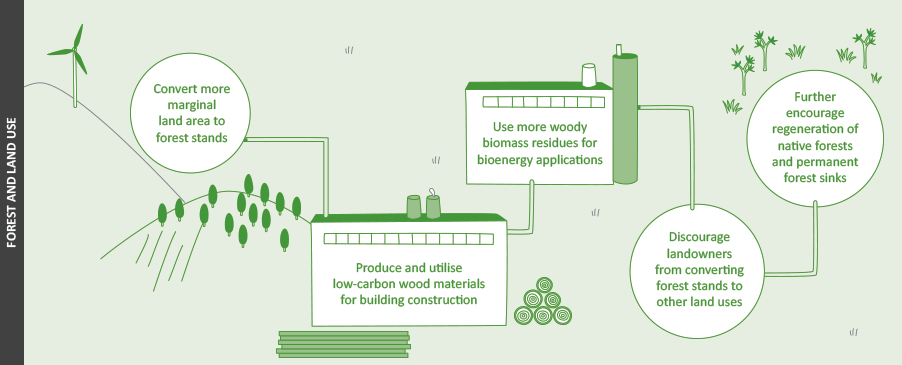Forests and land use
This section covers mitigation options for forest planting and other land-use. There are some opportunities to remove CO2 from the atmosphere using forest planting and changes to land use:
- Significantly increasing the land area of plantation forests could offset up to a quarter of our total GHG emissions over the next two to three decades. However, there are only low levels of planting at this time so when current forest stands are harvested our net emissions (gross emissions less CO2 removals) are likely to rise.
- Forest sinks can only be an interim solution until all available land has been planted.
In pictures

- Actions we can take in the forest and land use sector now towards a low-carbon future for New Zealand
Key findings
- New forest investment can make a significant contribution to New Zealand’s strategy on climate change mitigation, but should not be viewed as an alternative to implementing other direct mitigation actions.
- Reporting rules for forest and land use under the UNFCCC govern estimates of carbon stock changes, whereas accounting rules define what are the eligible mitigation actions, as in the NZ ETS.
- Increasing the area of planted forest can increase carbon sequestration (trees absorb CO2 and store the carbon as they grow) and hence provide further offsets for CO2 emissions from future combustion of fossil fuels and other GHGs arising from agricultural emissions.
- Planted forests also provide ecosystem services such as improved water quality, recreational benefits, shelter and reduced erosion particularly when planted on marginal land.
- Establishing new forests is currently the only large-scale mitigation option that can be easily implemented to sequester large amounts of carbon dioxide from the atmosphere.
- Recent new forest planting rates in New Zealand have been too small to significantly offset future CO2 emissions.
- Given that much of our post-1989 plantation forests are approaching maturity age, future emissions are likely to significantly increase when they are harvested, and hence our net GHG emissions over the next decade will also increase.
- Over 1 million ha of suitable land has been identified for further afforestation in New Zealand, but because there are ultimate land area limits due to land-use competition, the mitigation potential for forest removals in the long-term is unknown.
- Woody biomass residues from forest harvesting and wood processing operations can be combusted to provide useful heat, often cost competitively with coal or natural gas depending on location. In future, some of this resource could be converted to advanced liquid biofuels or chemical polymers.
- Soil carbon stock changes arising from land use change (such as from pasture to forest) are variable, poorly understood and difficult to assess, so are not easily incorporated within a carbon accounting system.
Read the summary
- Forests and other land-use, p18
Read the report
- Forests and other land-use, p148
- Sources of greenhouse gas emissions and sinks
- Global greenhouse gas emission trends for forests and other land use
- Greenhouse gas emissions profile and baseline trends in New Zealand
- Greenhouse gas mitigation options
- Co-benefits
- Knowledge gaps
